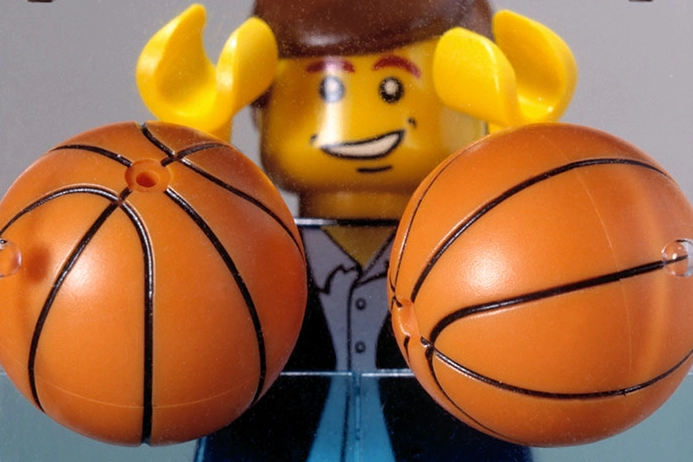The almost 70-year-old artist Jeff Koons is considered to be one of the most popular contemporary American creators. The follower of the Pop Art tradition whose interest revolves around being human in a consumerist society is known for his colourful sculptures of banal objects, and balloon animals. He first gained wide public attention in 1981 when he placed three hoovers and a cleaning machine into a glass case. His early readymades and later designs contributed significantly even to the sports industry through collaborations with brands such as Nike, Burton or BMW.
Basketball: Balance and social inclusion
At his first solo exhibition in 1985 at the International With Monuments Gallery in East Village, New York, Koons introduced his series of readymade sports objects titled Equilibrium. He realised the first sketches already in 1983, placing basketballs into glass cases on black pedestals filled with varying amounts of distilled water. The cases were made in three sizes to take one, two or three balls. While working, Koons even consulted experts so the submerged balls remained still and would not sink.
In his work Total Equilibrium Tanks the case is completely filled with distilled water with a small amount of sodium chloride, in another version, titled Two Ball 50/50 Tanks, the case is filled only halfway and the upper part of the ball floats above the water. Koons called this state of stability “final”, a paused moment of rest.
.jpg)
The exhibition also included posters with sports topics which Koons purchased in 1985 from Nike and later used as his own. The posters depict American basketball stars wearing Nike trainers and other branded equipment, surrounded by basketballs.
.jpg)
Koons compares the players on the poster with artists. He manages to capture the growing phenomenon of an athlete as a pop star. It is simultaneously the first instance, which later became iconic for Koons, where a product of pop culture is used for social commentary. Basketball became a tool of social mobility for people of colour, similar to the way art works in the “white” world. Jeff Koons hints at the power of the advertising industry which manipulates this dream and uses it in popular Nike posters from the 80s.
CARS: Art Car and comics
The German auto brand BMW started making their collection of sports cars in 1975, called Art Car. One goal of the collection, among others, was to support artists. Each car from the series was a different BMW model and a different artist was tasked with each design. The first model’s author was American author Alexander Calder, who created a red-blue-and-yellow design for the BMW 3.0 CSL as one of his last artistic projects. The cars from this series were regular competitors in the famous 24 hours of Le Mans race which aims to show innovative technical solutions for car design and to test their reliability and quality.

.jpg)
Among other artists contributing to this series were, for example, Andy Warhol, Roy Lichtenstein, Frank Stella, David Hockney, Robert Rauschenberg, Jenny Holzer and Olafur Eliasson. In 2010 Jeff Koons joined these icons, introducing the seventeenth BMW in the Art Car series in February of that year in front of the Centre Pompidou in Paris. The final look of the BMW M3GT2 is meant to evoke power, movement and surging energy. The silver interior together with the exterior’s colourful design give this model a dynamic look even while standing still. Koons wanted the car to look grand but also minimalist.

Koons followed up on the collaboration with BMW earlier this year with the limited series of BMW M850i x Drive Gran Coupe cars, titled The 8 X Jeff Koons. Unlike the previous car from the Art Car series, this is not merely an exhibition piece but also a limited collectors edition. There were 99 pieces made altogether. Each one is accompanied by a certificate signed by Koons who also designed the cover of the driver’s manual. One of the models has been auctioned off this April at the Christie's Auction House in New York in support of the International Center of the Missing and Exploited Children.
Koons completed the blue body of the car with yellow bumpers with comic book symbols - for example, the large POP sign on the back door. The car’s interior is upholstered with burgundy leather while the red and blue seats evoke Spider-man’s suit.
„I really enjoyed working with BMW,“ says Koons. „not only are they committed to producing quality vehicles, they’re also curious about new approaches, bringing in people from creative fields to reimagine what a product can be.“
LEGO
In 2010 artists John Cake and Darren Neave made Jeff Koons together with his basketballs as a Lego character. The series depicting famous artworks included, among others, Salvador Dalí and Damien Hirst.

SNOWBOARD: Plato and transcendence
The Philosopher is the title of another sports edition that Koons took part in between 2014 and 2016. This time with none other than Jake Burton, the founder of the Burton company.

Koons discovered his love for snowboarding came thanks to his children. He completely fell for the sport and compared his experience to a feeling of unity and transcendence. This is also the reason his model’s title references Plato’s Allegory of the Cave. In the snowboard’s visual Koons included an image of the young philosopher together with symbols depicting platonic solids. The largest foil stamps ever made for snowboard designs were created as a part of the boards’ manufacture. As is typical for Koons, the manufacturing process was extremely technically demanding and its realisation took two years. While Koons made the design, Burton was in charge of technical parameters. Both then tested individual prototypes.
The edition was hand-made at the Burton headquarters in Vermont and counted a humble number of 50 boards. The entire profit of The Philosopher model was donated to The Chill Foundation, founded by Jake and Donna Carpenter, supporting underprivileged youth taking part in board sports.
Ballet
One of the last sports projects is the near-14-metre-tall blow-up sculpture of a sitting ballet dancer which Jeff Koons placed in 2017 in front of the Rockefeller Center in New York. Its surface reflects the images of passers-by and is meant to represent a modern depiction of Venus.

Jeff Koons was born on the 21st of January 1955 in York, Pennsylvania. He studied art and design at the Maryland Institute College of Art in Baltimore and the School of the Art Institute in Chicago. In the late 70s, he moved to New York where he still lives and works today. During the 80s he became a respected artist and successfully entered the contemporary art market with his works originating in pop art, ready-made and conceptual art. Today he is considered to be one of the most famous and most expensive contemporary artists, working in large formats, usually with a group of assistants and his works intentionally tread on the line of kitsch.






